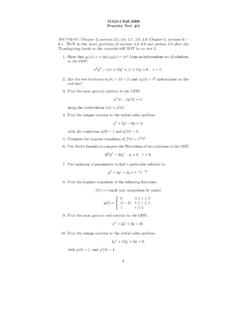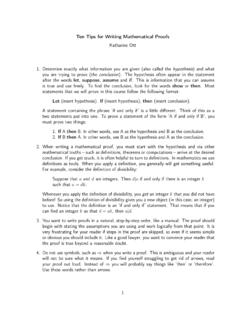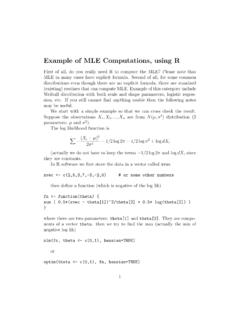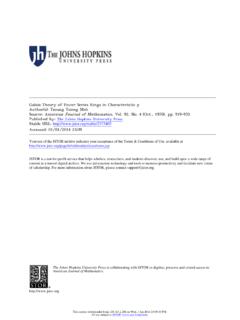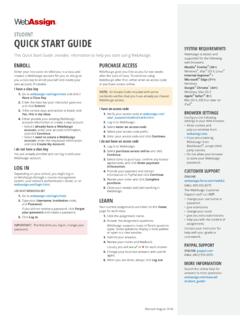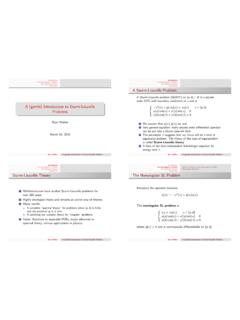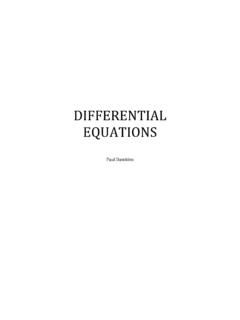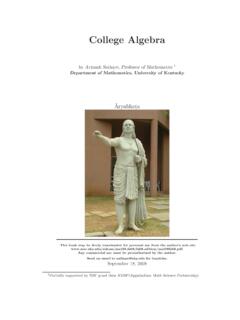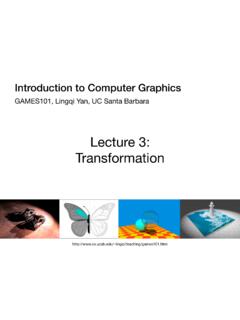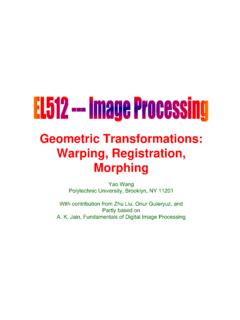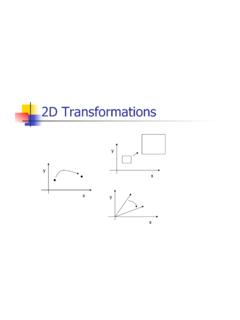Transcription of 7 - Linear Transformations
1 THuLTHvLTHu+vL=THuL+THvLTH 2uL= 2 THuL7 - Linear TransformationsMathematics has as its objects of study sets with various structures. These sets include sets ofnumbers (such as the integers, rationals, reals, and complexes) whose structure (at least from analgebraic point of view) arise from the operations of addition and multiplication with theirrelevant properties. Metric spaces consist of sets of points whose structure comes from adistance function. Various sets of functions with certain properties make up other objects withtheir structure coming from the operation of composition.
2 In Linear algebra the objects are setsof vectors with the operations of addition and scalar multiplication providing the structure. Inevery instance the most interesting and useful functions between these sets are those thatpreserve the structure-whether that is preserving distance, closeness, sums or products. In linearalgebra we call these functions or maps Linear V and W be vector spaces over the real numbers. Suppose that T is a function from V to W,T:V 6 W. T is Linear (or a Linear transformation ) provided that T preserves vector additionand scalar multiplication, for all vectors u and v in V, T(u + v) = T(u) + T(v) and for anyscalar c we have T(cv) = cT(v).
3 The picture above illustrates a Linear transformation T:Rn 6 Rn. If we assume that T is defined onthe vectors u and v (where it could be chosen without restriction), then its linearity forces T(-2u)and T(u + v) to be as T: R4 6 R2 by T(a, b, c, d) = (a + 3c, b - c + 2d). Then T is a Linear transformationfor let v1 = (a1, b1, c1, d1) and v2 = (a2, b2, c2, d2) be vectors in R4. T(v1 + v2) = T(a1 + a2, b1 + b2, c1 + c2, d1 + d2) = ((a1 + a2) + 3(c1 + c2), (b1 + b2) - (c1 + c2) + 2(d1 + d2))= (a1 + 3c1, b1 - c1 + 2d1) + (a2 + 3c2, b2 - c2 + 2d2)= T(v1) + T(v2)Thus, T preserves , if v = (a, b, c, d) and k is any scalar, thenT(kv) = T(ka, kb, kc, kd) = (ka + 3(kc), kb - kc + 2(kd)) = k (a + 3c, b - c + 2d) = kT(v)Hence, T preserves scalar multiplication and so is S: R2 6 R4 by S(x, y) = (0, x, x, y).
4 For any vectors (x, y) and (s, t) and any scalarc:S((x, y) + (s, t)) = S(x + s, y + t) = (0, x + s, x + s, y + t) = (0, x, x, y) + (0, s, s, t) = S(x, y) + S(s, t)and S(c(x, y)) = S(cx, cy) = (0, cx, cx, cy) = c (0, x, x, y) = c S(x, y).Therefore, S is a Linear T(x, y, z) = (x2, y + 3). Show that T is not Linear . T does not preserve addition since T((1, 0, 0) + (1, 0, 0)) = T(2, 0, 0) = (4, 3) yet T(1, 0, 0) + T(1, 0, 0) = (1, 3) + (1, 3) = (2, 6).This is sufficient to show that T is not Linear , but we also show that T does not preservescalar multiplication.
5 Indeed, T(2(0, 0, 0)) = T(0, 0, 0) = (0, 3) .. (0, 6) = 2T(0, 0, 0). example of a Linear transformation between polynomial vector spaces is D:P4 6 P3 givenby D(ax4 + bx3 + cx2 + dx + e) = 4ax3 + 3bx2 + 2cx + map T: M2 2 6 P3 defined by T= ax3 + bx2 + cx + d is a Linear S: P3 6 R2 given by S(p(x)) = (p(1), p(2)) where p(x) is any vector in P3 (and so anypolynomial of degree 3 or less.) Is S Linear ? v be some fixed vector in Rn, say for example v = (1, 2, 3, 1, 2, 3, ..). Define a map, T:Rn 6 R by using the dot product setting T(x) = x v. T is a Linear Transformations are defined as functions between vector spaces which preserve addition andmultiplication.
6 This is sufficient to insure that they preserve additional aspects of the spaces as wellas the result below that T: V 6 W is a Linear transformation and denote the zeros of V and W by 0v and 0w,respectively. Then T(0v) = 0w + T(0v) = T(0v) = T(0v + 0v) = T(0v) + T(0v), the result follows by property can be used to prove that a function is not a Linear transformation . Note that inexample 3 above T(0) = (0, 3) .. 0 which is sufficient to prove that T is not Linear . The fact that afunction may send 0 to 0 is not enough to guarantee that it is Linear .
7 Defining S(x, y) = (xy, 0) weget that S(0) = 0, yet S is not that T: V 6 W is a Linear kernel of T is defined by ker T = {v | T(v) = 0}. range of T = {T(v) | v is in V}. TheoremLet T: V 6 W be a Linear transformation . T is a subspace of V T is a subspace of kernel of T is not empty since 0 is in ker T by the previous theorem. Suppose that u andv are in ker T so that T(u) = 0 and T(v) = 0. Then T(u + v) = T(u) + T(v) = 0 + 0 = 0. Thus,u + v is in ker T. If, in addition, c is any scalar, we have T(cv) = cT(v) = c0 = 0. Hence, cvis in ker T which, therefore, is a subspace of 0 is in V, T(0) is in the range of T which is not empty.
8 Suppose that w1 and w2 are inrange T. Then there exist vectors v1 and v2 in V with T(v1) = w1 and T(v2) = w2. We thenhave v1 + v2 is a vector in V and T(v1 + v2) = T(v1) + T(v2) = w1 + w2, w1 + w2 is in rangeT. Also if w is in range T, say with v in V and T(v) = w, and c is any scalar, then cv is in Vand T(cv) = cT(v) = cw which shows that cw is in range T. Consequently, range T is asubspace of the Linear transformation T(x, y, z) = (x - 3y + 5z, -4x + 12y, 2x - 6y + 8z). Tocompute the kernel of T we solve T(x, y, z) = 0. This corresponds to the homogeneoussystem of Linear equations x - 3y + 5z = 0-4x + 12y = 0 2x - 6y + 8z = 0So we reduce the coefficient matrix to get.
9 1354120268 130001000 Hence ker T = {(x, y, z) | x = 3y and z = 0} = < (3, 1, 0) >.Range T = {T(x, y, z) | (x, y, z) is in R3} = {(x - 3y + 5z, -4x + 12y, 2x - 6y + 8z)| x, y, and z are real numbers} = {x(1, -4, 2) + y(-3, 12, -6) + z(5, 0, 8)| x, y, and z are real numbers} = < (1, -4, 2), (5, 0, 8) >. S: R3 6M2 2 be given by S(x, y, z) = . Then S is Linear and it is easy o see thatxzy0 ker S = {(0, 0, 0)} and range S = .100001000010 ,,For any function f: X 6 Y, f is said to be one-to-one if f(a) = f(b) implies that a = b (no two elementsof the domain of f map to the same element of Y.)
10 For any Linear transformation there is astraightforward method of determining whether or not it is one-to-one. It is an important reason whywe are interested in that T: V 6 W is a Linear transformation . T is one-to-one if and only if ker T = {0}.ProofSuppose that ker T = {0}. Let a and b be vectors in V with T(a) = T(b). Then T(a - b) = T(a) - T(b) = 0. Thus, a - b is in the kernel of T, so a - b = 0. Hence, a = b which shows that T , suppose that ker T .. {0} say v is in ker T and v .. 0. We then have T(v) = 0 = T(0) yetv .. 0. Hence, T is not one-to-one.
